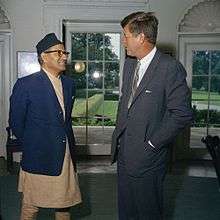Matrika Prasad Koirala
| Matrika Prasad Koirala मात्रिका प्रसाद कोइराला | |
|---|---|
 | |
| Royal Nepalese Ambassador to the United States of America | |
|
In office 1961–1964 | |
| 18th Prime Minister of Nepal | |
|
In office 16 November 1951 – 14 August 1952 | |
| Monarch | Tribhuvan |
| Preceded by | Mohan Shamsher Rana |
| Succeeded by | Direct Rule by King Tribhuvan |
|
In office 15 June 1953 – 14 April 1955 | |
| Monarch | Tribhuvan, Mahendra |
| Preceded by | Direct Rule by King Tribhuvan |
| Succeeded by | Direct Rule by King Mahendra |
| 1st President of the Nepali Congress | |
|
In office 12 April 1950 – 26 May 1952 | |
| Succeeded by | Bishweshwar Prasad Koirala |
| Personal details | |
| Born |
1 January 1912 Varanasi, British Raj |
| Died |
11 September 1997 (aged 85) Biratnagar, Nepal |
Matrika Prasad Koirala (Nepali: मात्रिका प्रसाद कोइराला ![]() Listen ; 1 January 1912 – 11 September 1997)[1] was the Prime Minister of Nepal for two terms (16 November 1951 – 14 August 1952 and 15 June 1953 – 14 April 1955).[2]
Listen ; 1 January 1912 – 11 September 1997)[1] was the Prime Minister of Nepal for two terms (16 November 1951 – 14 August 1952 and 15 June 1953 – 14 April 1955).[2]
Personal life
Koirala was born to Krishna Prasad Koirala and his first wife Mohan Kumari Koirala in 1912 in Varanasi, British Raj.
Political career
Matrika Prasad Koirala was politically active in India where his father Krishna Prasad Koirala was living in exile. He stayed in the house of Dr. Rajendra Prasad, the first President of free India and was influenced by the Indian Independence Struggle. He participated in the Indian independence movement with his brother Bishweshwar Prasad Koirala. Both brothers were arrested and imprisoned by the British Raj for three months in 1930.[3] He was made President of the Congress Party in Bihar by Dr Rajendra Prasad for a while as all the other senior Indian leaders were jailed during the Quit India Movement.
He later joined the Nepali National Congress led by Tanka Prasad Acharya and fought against the Rana regime. Koirala became the first President of Nepali Congress, when it was formed as a result of the merger of Nepali National Congress and Nepal Democratic Congress in April 1950.[4] Koirala became the first commoner Prime Minister of Nepal after Rana rule ended.
In 1952, he was expelled from the Nepali Congress for "violating the party principles and acting against the Constitution of 1951".[5]
Koirala also served as Nepal's permanent representative to the UN and ambassador to the United States from 1961 to 1964.[6]
His father's name is Krishna Prasad Koirala. Krishna Prasad died in prison of Rana regime on the suspicion of keeping the great leader of India, Jaya Prakash Narayan In his home in Biratnagar, Nepal when he was wanted by British Government of India
Krishana P ra sad had five sons when he died. M.P.Koirala, BP Koirala, Keshab Prasad Koirala, Tarini Prasad Koirala and Girija Prasad Koirala .Out of these five sons three sons MP, BP and Girija Prasad Koirala became Prme ministers of Nepal at different periods of modern Nepal' history.Tarini Prasad established Radio Nepal. Keshab Prasad was military governor of Morang district in revolution of 1951 and later was elected Chairman of Biratnagar municipality, grandsons of Krishna Prasad, Kamal Prasad Koirala, Prakash Koirala, Shekhar Koirala, Shashank Koirala, grand daughter Shailja Acharya became elected members of the House of Representative at different periods. Shailja Acharaya and another granddaughter Sujata became deputy prime ministers.| Political offices | ||
|---|---|---|
| Preceded by Mohan Shamsher Jang Bahadur Rana |
Prime Minister of Nepal 1951–1952 |
Succeeded by Direct rule by Tribhuvan Bir Bikram Shah Dev |
| Preceded by Direct rule by Tribhuvan Bir Bikram Shah Dev |
Prime Minister of Nepal 1953–1955 |
Succeeded by Direct rule by Mahendra Bir Bikram Shah Dev |
References
- ↑ Nepal: Former prime minister dies
- ↑ worldstatesmen.org
- ↑ Uhash, Rupesh. "Bisheshwor Prasad Koirala". Spiny Babbler. Retrieved 27 December 2013.
- ↑ Nepali Congress:An introduction
- ↑ "Nepali Congress". Important Landmarks. Nepali Congress. Retrieved 26 December 2013.
- ↑ "Frist Lions Club in Nepal". Lions Clubs International District 325 A1 Nepal. Lions Club. Retrieved 27 December 2013."He was nominated as a permanent representative of United Nations Organization and was appointed as Nepal’s Ambassador to United States of America from 1961-64
